Self-Regulated Learning in Organic Chemistry: A Platform for Promoting Learner Agency Among Women of African Descent
Published in:
November 22–23, 2019
University of Miami
Miami, Florida
Introduction
In recent years, trends have highlighted the importance of varying instructional approaches, such as active and collaborative learning, as methods in which students are encouraged to interact and grapple with course content. The implementation of such approaches has been linked to increases in academic achievement for many students, including those of underserved student populations. The effect on students’ ability to engage in self-directed and self-regulated activities has been noted as a significant benefit of these approaches. Various definitions of self-regulated learning theory (SRL) have been used to study the ways in which students learn and study to achieve success within education. Self-regulated learning includes the thoughts, feelings, and actions taken to attain an individual’s goal(s). In this paper, we use Zimmerman’s definition of SRL “the degree to which students are metacognitively, motivationally, and behaviorally active participants in their own learning process” (Lopez, Nandagopal, Shavelson, Szu, and Penn, 2013; Zimmerman & Schunk, 2001). Self-regulation speaks to the students’ ability to take an active role, contrary to the passive role generally found in lecture-only classrooms. Instead, students use their academic skills to engage in outcome-driven behaviors that move them towards success.
Guided by metacognition, students who are highly self-regulated are able to utilize their metacognitive skills as a self-directed process. Zimmerman’s work presents a cyclical process in which individuals move through a series of phases including forethought (planning), performance (doing) and self-reflection (assessing) (Dunn & Lo, 2015; Schunk & Zimmerman, 2012; Zimmerman & Schunk, 2001). The first phase, forethought, occurs before performance and is the stage at which individuals analyze the task(s) at hand, identify goals, and map out a plan. The next phase, performance, is where students actually participate in the learning process and engage in self-control and self-monitoring. The self-control process focuses on implementing the cognition, motivation, and behaviors identified in the forethought phase as leading towards success, while self-monitoring is the process of observing learning as a means to inform the self-control practices. The final phase of self-reflection is a process of self-evaluation and self-satisfaction.
Affective traits such as agency influence the use and development of cognition and metacognition required for self-regulated learning (Cooper & Sandi-Urena, 2009). Agency is activated by an individual’s intrinsic motivation (why I act), efficacy (do I believe I have the ability to act), self-beliefs (do I believe my actions will lead to intelligence), and effort (do I act) (Vidal-Abarca & Mañá, 2010). The affective trait has been used to describe the extent to which the learner is willing to engage in the learning environment and become an active participant in the learning process (Vidal-Abarca & Mañá, 2010; Shin, Jonassen & McGee, 2003; Rickey & Stacy, 2000; Schraw, Crippen & Hartley, 2006). A student’s level of agency is closely related to their decision to use self-regulation strategies as a learner (Scherer & Tiemann, 2012).
This work describes the organic chemistry classroom at Spelman College. Specifically, we focus on the performance phase of self-regulation and examining elements of agency, specifically the use of study skills/habits, mindset, metacognition, and motivation.
Course Format
Two flipped learning formats have been operationalized for the course utilizing: 1) pre-class readings/questions and problem sets in Format 1 of the course and 2) pre-class video, readings, and online quizzes in Format 2 of the course. In both courses, the class period involves peer-led learning in small groups.
Format 1 was used in one section of the course enrolling 31 non-chemistry/biochemistry majors, primarily sophomores and juniors. The course was taught in a flipped format and the required text was Klein 3rd edition. Supplemental materials were provided online through the learning management system, Moodle. In this format pre-class questions and readings served to familiarize students with the material relevant to the in-class activities. The instructor reviewed students’ responses to pre-class activities to gain insight into challenges students encountered in answering the questions. The in-class assignments primarily included traditional problem sets, guided inquiry, and board work while homework consisted of both traditional and online problem sets. Technology tools such as Nearpod allowed for simultaneous “board work” or clicker questions, Figure 1 (Burton, 2019).
Assessments for the course included high and low stakes activities. Low stakes assignments, activities which had minimum impact on the overall course grade, were used to ensure participation and engagement, to scaffold learning, and to create student-student and student-instructor feedback loops. The consistent feedback allowed students to monitor their progress and take note of the practices that benefit their success. One feature of the course that was used for structure and feedback is the course notebook. Students compiled their notes, assignments, and additional worked problems for each topic. Emphasis was placed on additional problems by the instructor. The notebook served as an indicator of the effort put forth by the student. In cases where a student was not meeting their academic goals in the course, the notebook was used to discuss strategies and techniques that could help the student based on their personal study habits and effort. High stakes activities, those which contributed significantly to the grade, included exams and quizzes which were used to assess concept mastery.
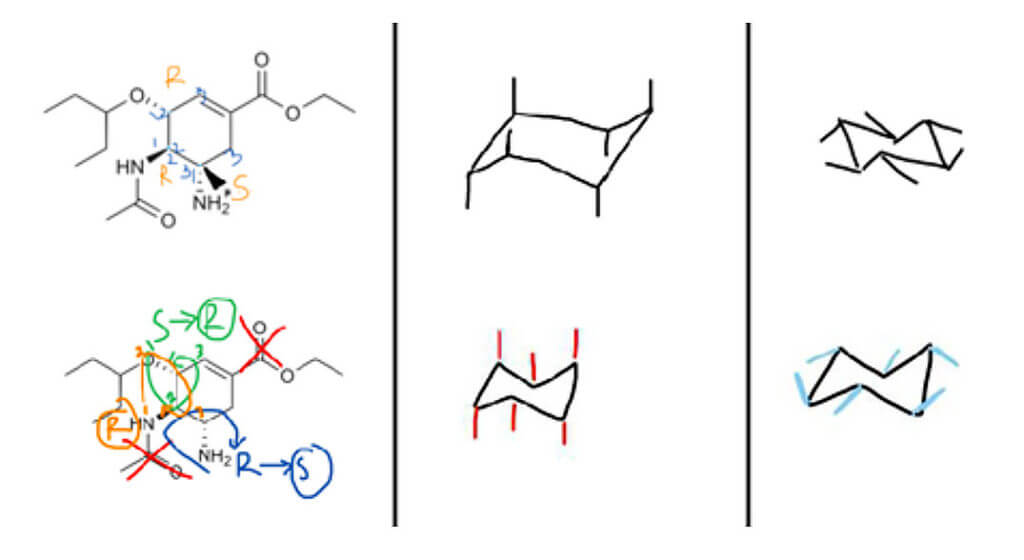
Format 2 was used across two sections of the course enrolling a total of 59 students. One section is primarily chemistry/biochemistry majors whose general chemistry course was taught in a flipped learning format. The second section is primarily non-chemistry/biochemistry majors. Like Format 1, Format 2 promotes self-regulated learning through interactive engagement and flipped instructional pedagogies. There is no assigned textbook for the course although the Klein text is a recommended supplement. Content is delivered through online instructor recorded lectures with embedded quizzes, instructor’s notes, and guided reading assignments. The class period is reserved for skill building through computational modeling (Figure 2A and B), analogies, traditional problem drills, guided inquiry, and learn by drawing exercises. Assessment on content mastery included exams and quizzes.
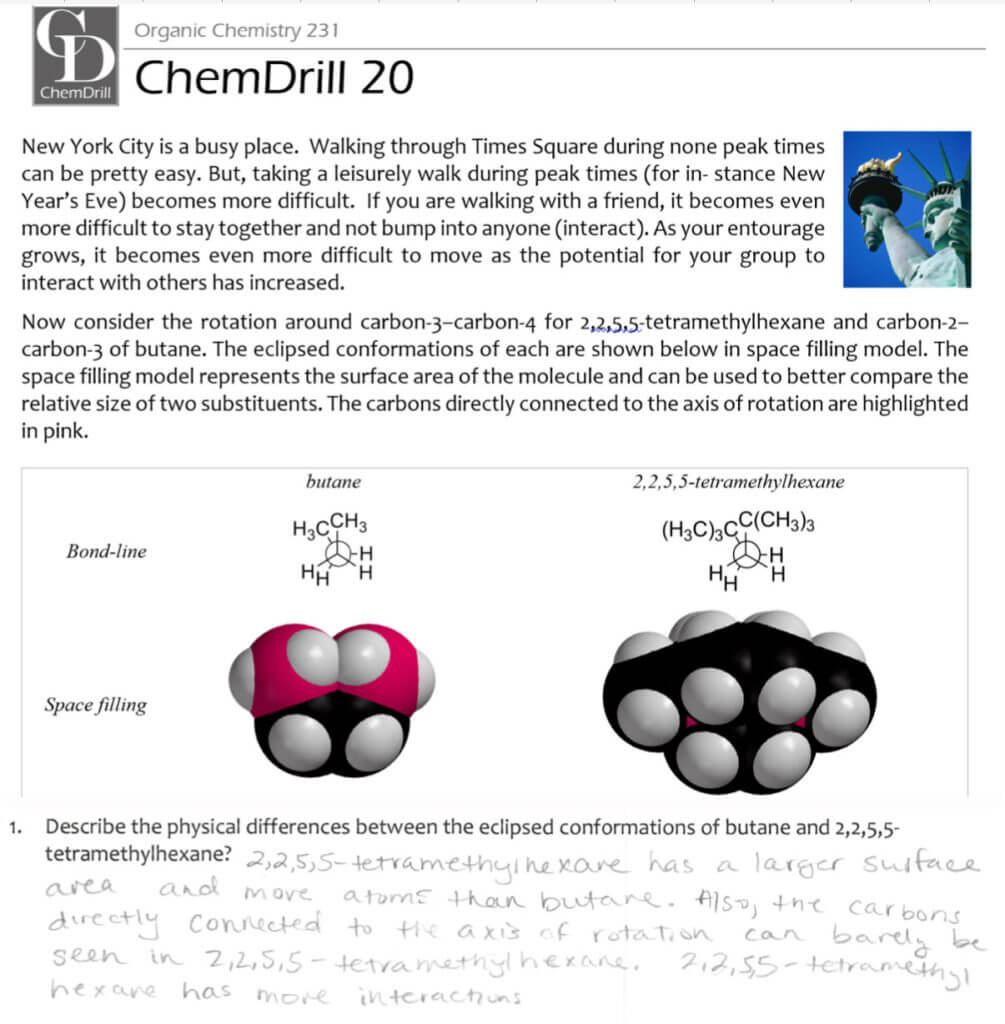
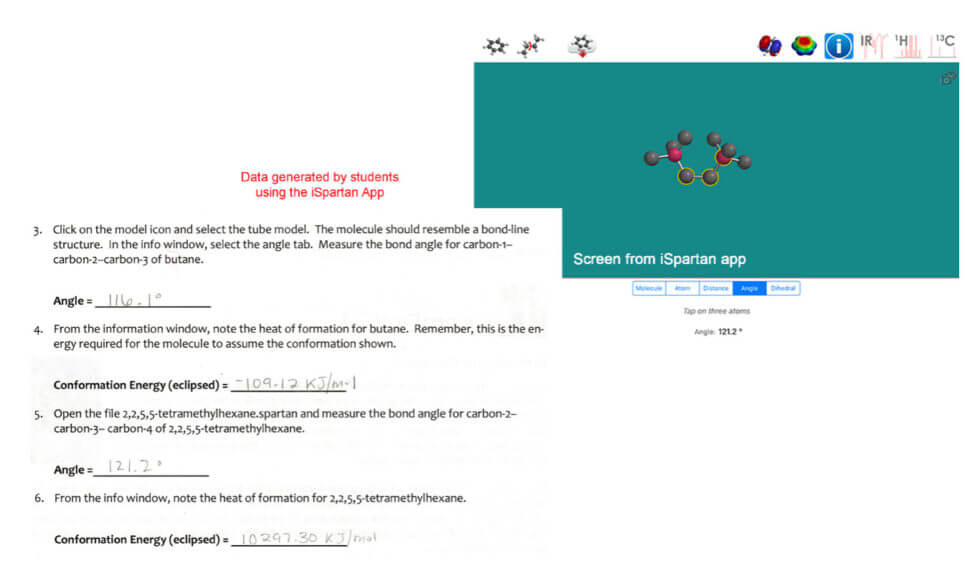
Methods for the Assessment of Students’ Learning Characteristics
The organic chemistry courses have been modified to encourage collaboration inside and outside of the classroom by creating an environment rooted in active learning and engaged participation. The revised course structure adds value to the organic chemistry lectures by encouraging students to work together, be creative, and share their diverse perspectives. Ultimately, it is believed that success in this environment requires students to utilize appropriate self-regulated learning strategies. Therefore, in addition to describing the learning environment, this work asks: 1) How do students engage in this environment? and 2) What are the characteristics of students who engage successfully in this environment?
Participants were recruited from three Organic Chemistry I courses. A total of 72 students participated. Students’ content knowledge was measured through course exams, which were administered four times throughout the term, and through a common final exam at the end of the semester. Four assessment instruments were administered at the beginning and end of semester to characterize students’ mindsets, attitudes towards chemistry, and study habits. The Metacognitive Activity Inventory (MCAI) was utilized to assess students’ metacognitive skillfulness relative to their approach to chemistry problem-solving. In addition to the data collected from the MCAI, Dweck’s Theories of Intelligence Scale was used to identify student mindset and the Chemistry Motivation Questionnaire II (CMQII) measured specific motivations for learning chemistry. Influenced by the work of John Dunlosky (2013), a survey created at Spelman College focused on the use of various study habits and group engagement. Study habits queried included:
- Rereading: restudying text material again after an initial reading.
- Highlighting and underlining: marking potentially important portions of to-be-learned materials while reading.
- Summarization: writing summaries (of various lengths) of to-be-learned texts.
- Keyword Mnemonic: using keywords and mental imagery to associate verbal materials.
- Imagery for Text: attempting to form mental images of text materials while reading or listening.
- Practice Testing: self-testing or taking practice tests related to course concepts.
- Distributed Practice: implementing a schedule of practice that spreads out study activities over time.
- Interleaved Practice: implementing a schedule of practice that mixes different kinds of problems, or a schedule of study that mixes different kinds of material, within a single study session.
- Self-explanation: explaining how new information is related to known information, or explaining steps taken during problem-solving.
- Elaborative Interrogation: generating an explanation for why an explicitly stated fact or concept is true.
Frequency of use of Study Strategies
Among the study strategies reviewed by Dunlosky, the most impactful study strategies are elaborative interrogation, self-explanation, interleaved practice, and distributed practice (2013). Reading and highlighting are known to be among the least effective methods for mastering a concept. Summarizing can be useful, but requires modeling. Imagery for text can have limited utility in that it requires concepts to which imagery can be applied, given that many of the concepts require visual interpretation. Fortunately, organic chemistry provides numerous opportunities to apply this strategy. Keyword mnemonics work well for languages. As organic chemistry is often believed to be a language given the volume of jargon associated with the course, this study strategy can be particularly useful. In Figure 3, respondents report the use of all study strategies with varying frequency.
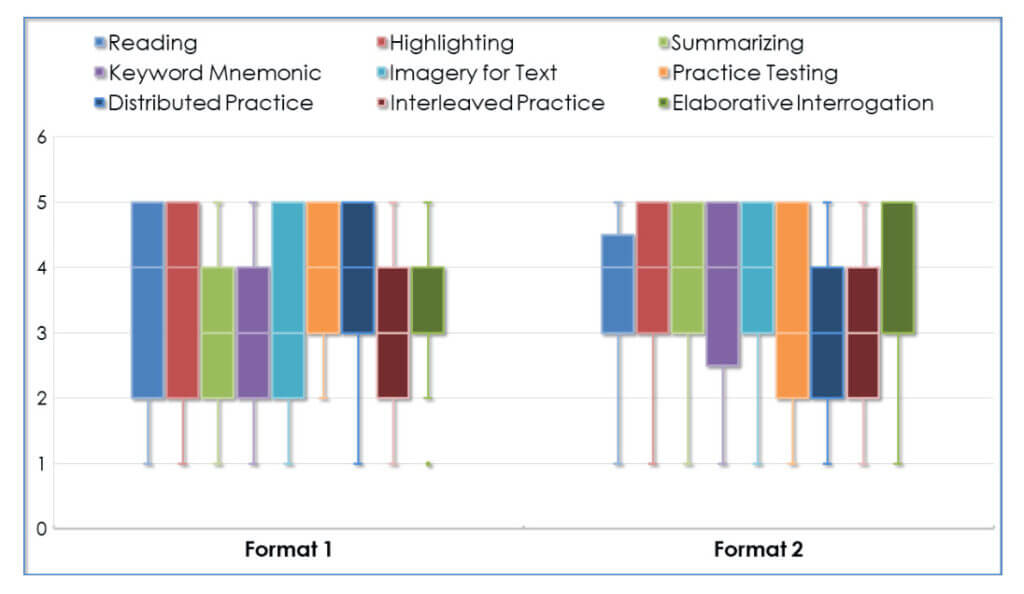
Respondents enrolled in Format 1 of the course primarily reported the use of practice tests as the preferred method of study, Figure 4. There was a spread of preferred study strategies reported by respondents enrolled in Format 2 of the course with reading/rereading, practice testing, and distributed practice being the top three, Figure 4.
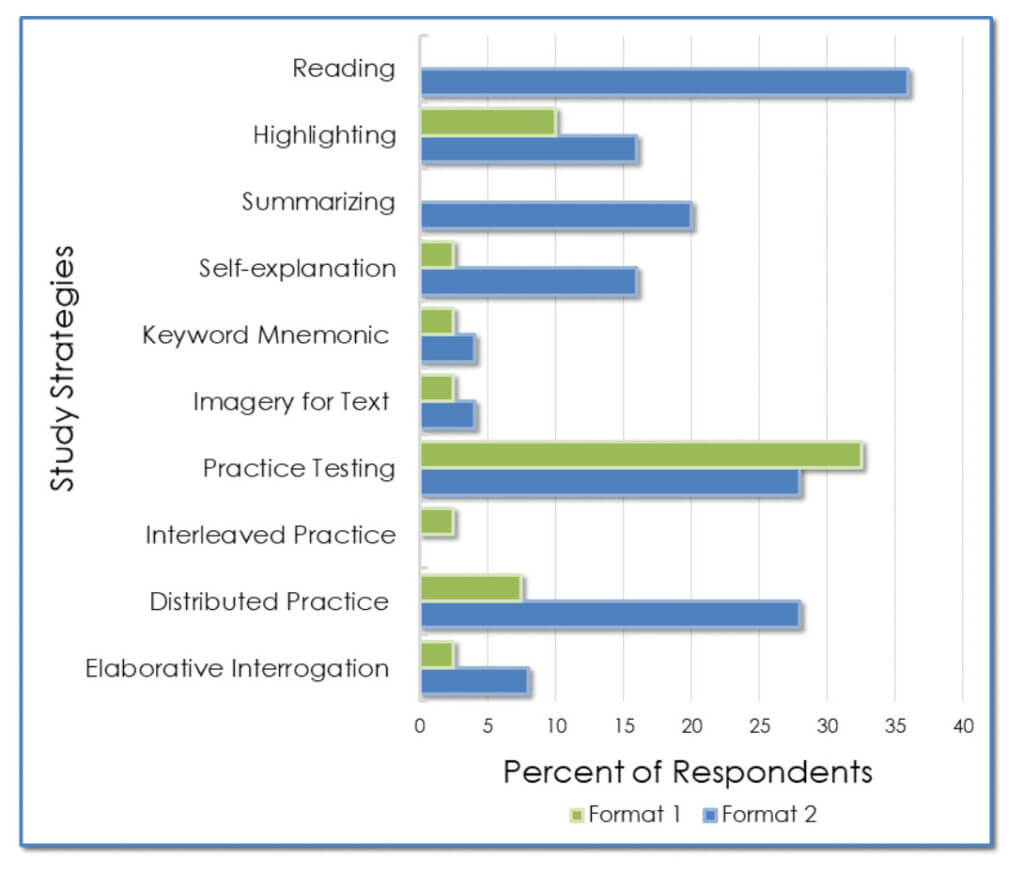
There was no significant difference in the course or exam performance based on the preferred method of study. However, students contributing to the highest overall course performance for Format 1 preferred the use of elaborative interrogation and self-explanation. For Format 2, this group of students preferred the uses of keyword mnemonics.
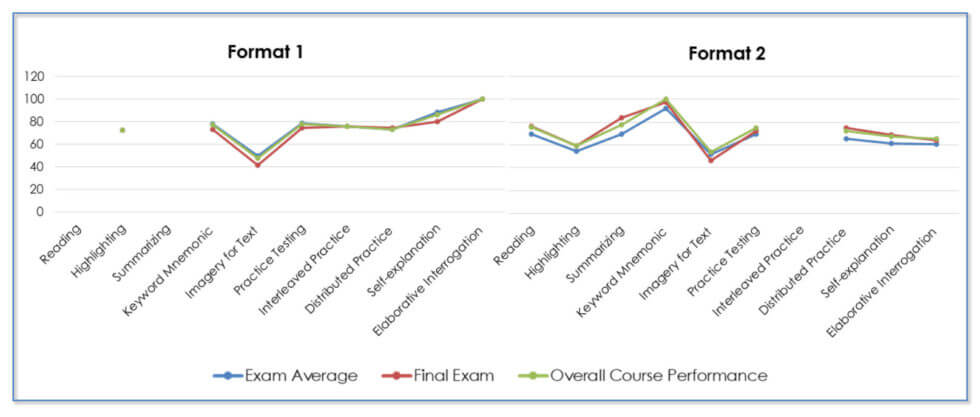
Motivation
Respondents enrolled in all formats of the course demonstrate high career and grade motivation. Similarly, respondents had high self-determination with slightly lower intrinsic motivation and self-efficacy. Examining the various components of motivation, there appears to be some correlation between the frequency with which students used higher impact study strategies and self-determination and grade motivation, Figure 6.
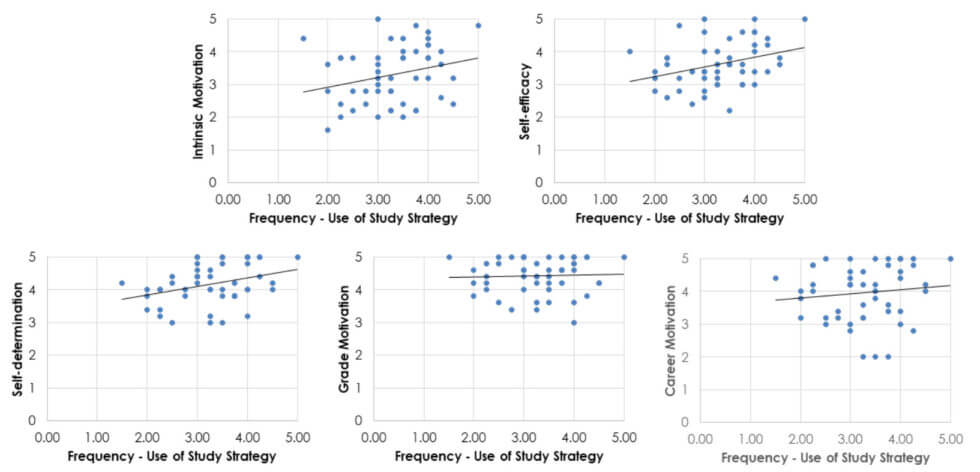
Student Engagement in Class
Both formats of the course feature collaborative learning during the class period. Students responding to a survey created in-house reported that they prepared to engage in the in-class activities and participated in the discussion, Figure 7. In addition, respondents believed that the activity had value toward their understanding of course concepts.

Mindset and Metacognition
Further analyzing study strategies against mindset and metacognition showed that across all groups, practice testing stood out as the preferred study strategy. Respondents also relied heavily on highlighting, summarizing, and reading. Distributed practice was utilized more often by the Low Growth Mindset/High MCAI group in comparison to the other groups.
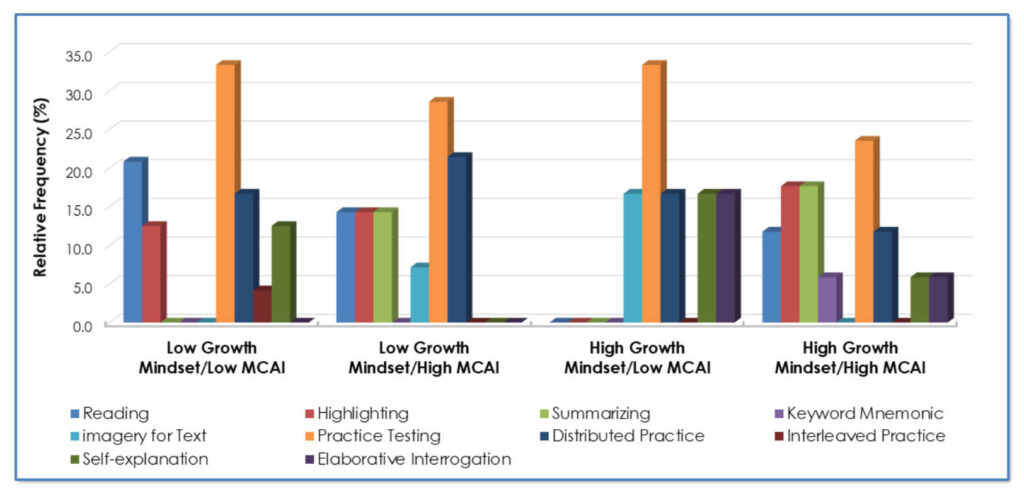
Conclusion
The frequent assessment and varied assignments provided through formats of the course encourages students to engage with the material both inside and outside of class. The structure of the course allowed students to engage in low stakes activities and receive immediate feedback. Although the active learning formats for each course varied, the flipped format may have influenced students to adopt specific study types more than others. Further work is needed to characterize the teaching presence to understand how it can intentionally promote and direct self-regulated learning among students. Collectively, these efforts provide insight into females of African descent as agents of their success.
This work has been funded in part by the National Science Foundation Award Numbers 1332575, 1912385 and 1626002
References
Burton, R. (2019). A review of Nearpod–an interactive tool for student engagement. Journal of Applied Learning and Teaching, 2(2), 95-97.
Cooper, M. M., & Sandi-Urena, S. (2009). Design and validation of an instrument to assess metacognitive skillfulness in chemistry problem solving. Journal of Chemical Education, 86(2), 240.
Dunlosky, J. (2013). Strengthening the student toolbox: Study strategies to boost learning. American Educator, 37(3), 12-21
Dunn, K., & Lo, W. (2015). Understanding the influence of learners’ forethought on their use of science study strategies in postsecondary science learning. International Journal of Science Education, 37(16), 2597-2618
Lopez, E. J., Nandagopal, K., Shavelson, R. J., Szu, E., & Penn, J. (2013). Self-regulated learning study strategies and academic performance in undergraduate organic chemistry: An investigation examining ethnically diverse students. Journal of Research in Science Teaching, 50(6), 660–676. doi: 10.1002/tea.21095
Rickey, D., & Stacy, A. M. (2000). The role of metacognition in learning chemistry. Journal of Chemical Education, 77(7), 915.
Scherer, R., & Tiemann, R. (2012). Factors of problem-solving competency in a virtual chemistry environment: The role of metacognitive knowledge about strategies. Computers & education, 59(4), 1199-1214.
Schraw, G., Crippen, K. J., & Hartley, K. (2006). Promoting self-regulation in science education: Metacognition as part of a broader perspective on learning. Research in science education, 36(1-2), 111-139.
Schunk, D.H., & Zimmerman, B.J. (Eds.). (2012). Motivation and self-regulated learning: Theory, research, and applications. Routledge.
Shin, N., Jonassen, D. H., & McGee, S. (2003). Predictors of well‐structured and ill‐structured problem solving in an astronomy simulation. Journal of research in science teaching, 40(1), 6-33.
Vidal-Abarca, E., Mañá, A., & Gil, L. (2010). Individual differences for self-regulating task-oriented reading activities. Journal of Educational Psychology, 102(4), 817.
Zimmerman, B.J. (1990), Self-regulated learning and academic achievement: An overview. Educational Psychologist, 25(1), 3-17
Zimmerman, B.J. & Schunk, D.H. (Eds.). (2001). Self-regulated learning and academic achievement: Theoretical perspectives. Routledge.
Spring 2020: Critical Conversations and the Academy
